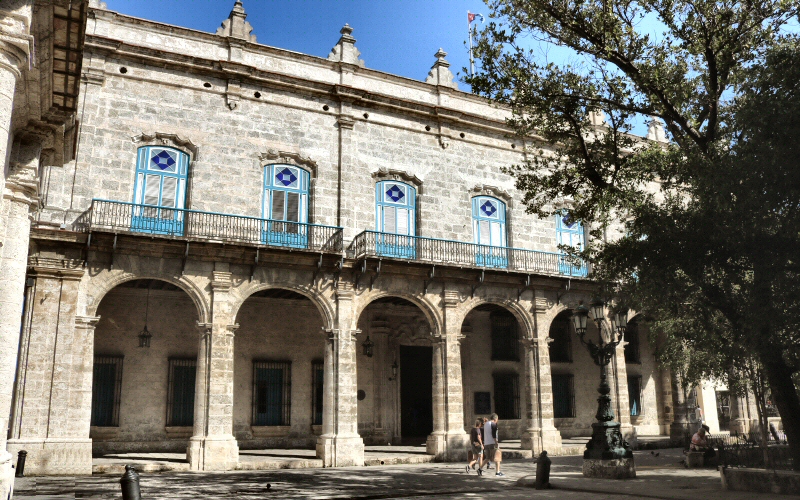

ARCHITECTURAL FEATURES
The building is a combination of baroque
style with the neoclassical concept, fairly inspired by the
Moorish architecture. It is made of limestone, full of holes and
calcareous marine incrustations.
The building has two floors
around a central courtyard and a mezzanine on the
right wing. On the northeast side
there is a tower. The main façade has a wide arcade with elegant
semicircular arches that open to the O’Reilly street. The shadow
of the arcade offers an ideal place to take a breather for the
people that escape from the torrid heat. The blue-white windows,
overlooking the central courtyard, feature Cadiz style shutters.
The building was painted until the late 1930s, when exposing the
stone in mansions became popular.
The building is accessed through a
majestic door, and then a hallway that has an iron inner door.
The illustrious Andalusian style patio is surrounded by
harmonious succession of columns with semicircular arches that
support the upper floor. A fountain is present at one corner of
the courtyard. On the upper floor, the cloister galleries are
closed with French carpentry.
At the entrance of the exhibition galleries there is an electronic model of the earth globe on which the four voyages of Christopher Columbus are displayed. The first exhibition gallery is like a “time tunnel”. The important events that influenced Cuba and Europe are given chronologically. The right side of the tunnel shaped panel is reserved for Europe, and the left side for Cuba. In the next room the walls are covered by the led panel photographs of some renown personalities. The necessary information about the work of these personalities is given in English and in Spanish on touch screens in the room.
On the upper floor there are several
exhibition rooms with different themes. In one room the
formation and the development of Havana are displayed on photos
and led panel photographs. The panels are written in English and
in Spanish. In another room the instruments that were used
mainly in navigation, such as quadrant, octant, sextant, sand
clock, telescope and different types of compasses, are
illustrated on a panel. In the next room old maps are exhibited.
Old maps of Cuba deserve to have a look. The theme of the next
room is the development of the press in Cuba. Unfortunately,
everything is explained on panels. Two oil paintings enrich the
walls of another room. They are the works of the Belgian painter Gustave Wappers and the Spanish painter Francisco Sans Cabot.
The former painting represents the moment when the Puritans,
persecuted because of their religious beliefs and after a
dangerous journey on the ship, named Mayflower, landed in 1620, on the
coasts of New England, where the city of Plymouth is today, and
the latter the arrival of Hernán Cortés in Mexico. Hernán Cortés
is the conqueror of Mexico, being responsible of the bloody
overthrew of the Aztec Empire.